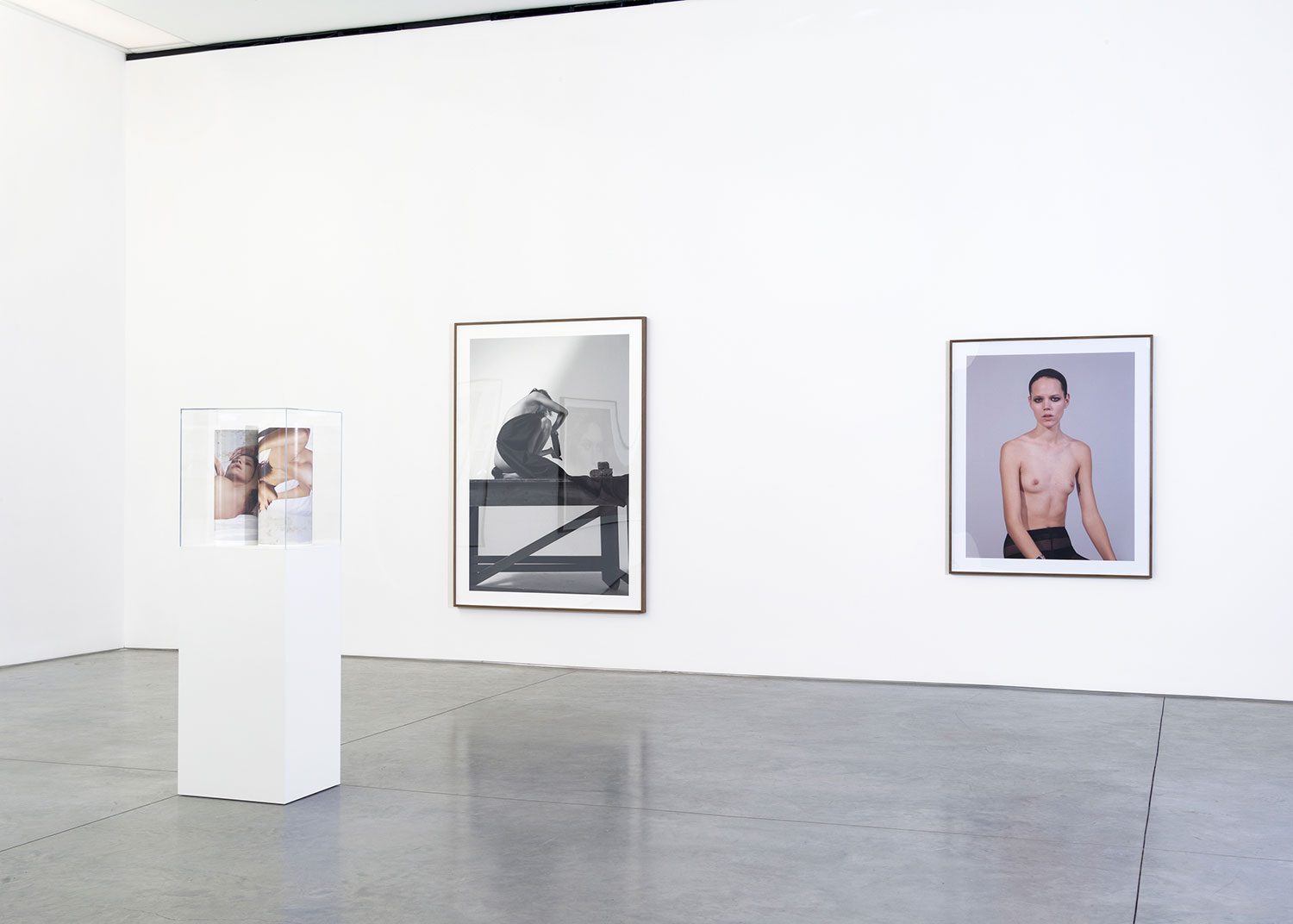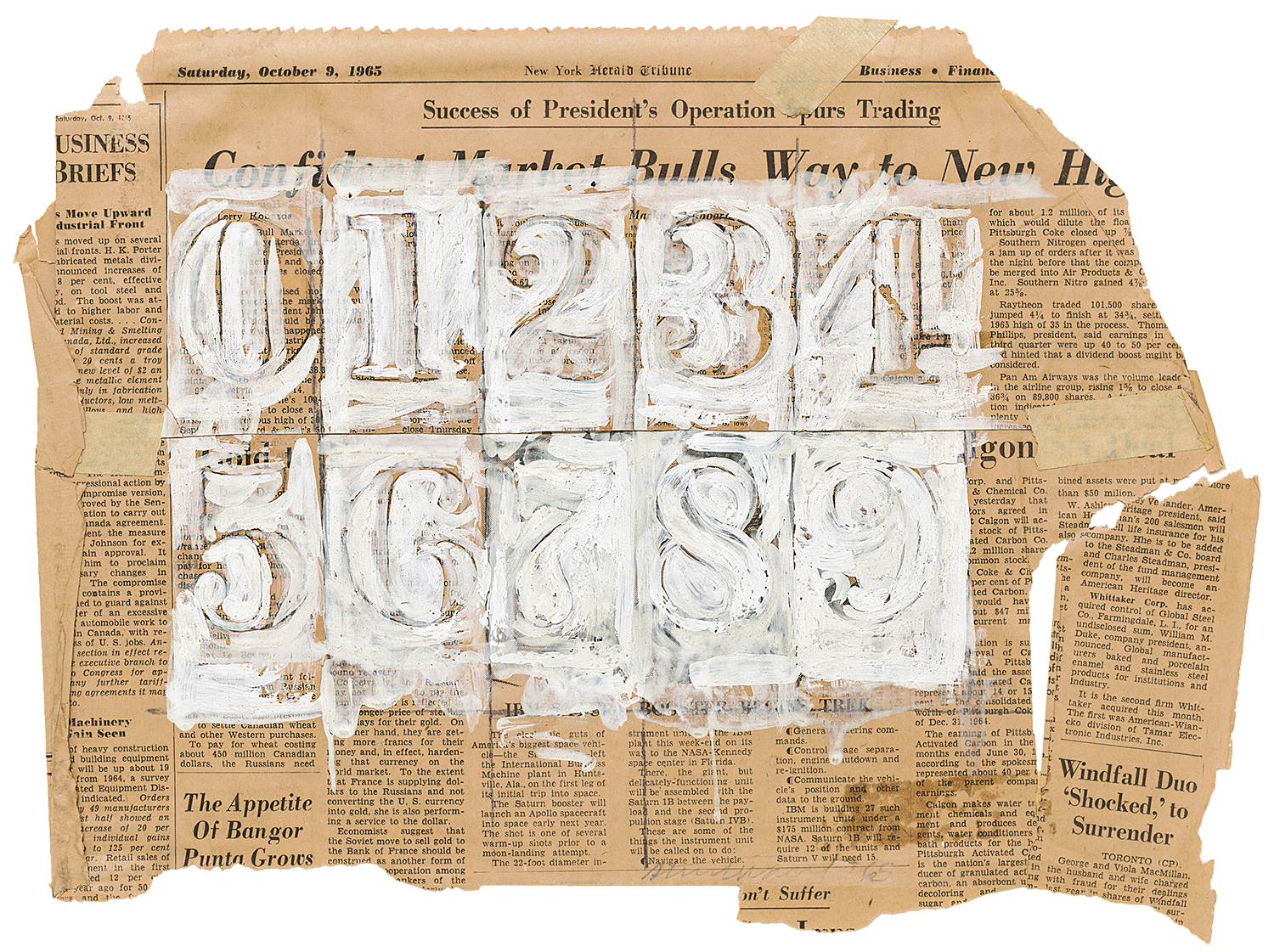
He Jing: Let’s set aside for now the question of whether your works are “abstract.” Something people find interesting in your work is the repetitive act of painting. Li Shurui, you have said before that your repetition is somewhat compulsive in nature, but I think that “repetition” is a kind of choice.
Li Shurui: I think that the majority of the traits of painting are compulsive to a certain extent, because they are too “physical.” You must spend several hours a day within that working method. Much of the time you are working very mechanically, and in time it will certainly take on a form of physical logic. The choice to use this method to “kill” a few hours every day eventually becomes a very physical response.
Xie Molin: “Repetition” is sometimes done to get into the task. Actually, it may look like repetition, but each day under repetition is different. I am more concerned with the different possibilities that take form within the repetition process. Then, through repetitive labor, I grasp onto these possibilities and fix them in place, turning them into a new image.
Wang Guangle: I agree with what Li Shurui said about the operation of the body. It is all repetition. For instance, today we are sitting here having a discussion. Tomorrow I will go to my studio to paint. For me, time is repetitive. It is an endless series of mornings and afternoons. The subject of my painting is not an object or a thing that definitely exists, but I think that if you take away that content, time really is repetitive.
HJ: I’ve suddenly noticed that this repetitive painting process you are discussing is largely a private experience, while what the viewers see in the exhibition is the resulting painting.
WG: I really enjoy this privacy of painting. That’s not to say I’ll go paint something and never show it to anyone. The overall behavior of society today is more goal-oriented. For me there is this resulting painting. Once you have experienced this outcome, it encompasses that goal. But if you go back to the source, it is still very individual.
HJ: As for controlling the painting process and the resulting image, I would guess that the three of you each have different approaches. Xie Molin certainly revels in the precision of this process.
LS: I don’t have any clear expectations. Before, I would make a study and follow it, but in recent years, I have been painting extemporaneously, so I have to spend more time with my paintings. I have actually been avoiding working toward a particular result. I hope the results stray from the trajectory I originally set. Otherwise, there would be no surprises.
XM: I am led by the labor, following possibilities that emerge as I work with the machines and paints in my studio, making decisions throughout the process. These possibilities can be ascribed to “control,” and in the labor process, I gain feedback and come across surprises. These surprises prompt me to make judgments.

HJ: So in the end, are you controlling the outcomes or are the outcomes controlling you?
WG: A little of both. For example, the repetitive motions in my works form into a pattern, and I set this pattern, but a lot of the time, when you get halfway through it, you realize that you are being controlled by a picture. At that point, you become a part of the brush, serving to complete this picture. So it’s a little of both.
HJ: This calls to mind two things that could be more or less the same or very different: “painting” and “producing an image.”
LS: I think that all three of us lean toward “painting,” because as the physical experience accumulates, something akin to faith begins to emerge within the overall process. I would define this chemical reaction as the watershed that divides “painting” from “producing an image.” In these days, producing an image is very simple work. You can put it into an intensive artificial mode of production. But I think that bodily participation is a very essential component of painting.
HJ: In my experience, the “painter” is a very traditional concept. As for the distinction between “painting” and “producing an image,” I don’t think it’s so clear. There is a lot of overlap.
WG: None of us strictly fit into “image” painting. I think that in the Chinese context, “image” refers more to figurative painting, but I still tend to call myself a “painter.” That is to say, I am more concerned with the process, and guiding this process. As I work, an outcome will inevitably emerge. I can’t say, however, that I have not considered the final outcome, and so in the artwork, these are a unified whole. I cannot choose between “not considering the image” and “considering the image.”
XM: I don’t know whether Li Shurui feels that tools have a strong influence over her, but for me, owing to the intervention of these new creative tools, I have come to a different understanding of the once familiar academy approach to painting. Of course, these outcomes are intentional. I have not put too much thought into the “production of images.” I pay a lot of attention to the operation of the process.

HJ: It is perhaps not quite so apparent in Li Shurui’s paintings, but there is a very strong material quality to Wang Guangle’s and Xie Molin’s painting practices, including what we see in the final outcome — such as the components that expand beyond the frame (as in Wang Guangle’s “Coffin Paint” series). This immediately raises the question: Is it sculpture? For instance, Wang Guangle speaks of one layer of paint covering the next. As time passes, we can see this as a “sculpting” process. Why is this painting rather than sculpture?
XM: I think that my artworks are still very traditional paintings; it’s just that the material aspect lies in the texture of the paint, leading to a different visual effect. I think that sculpture is still three-dimensional space. I graduated from the mural department, and in mural painting, there is the concept of “relief.” I think that my works are closer to this. They are not entirely three-dimensional.
WG: My works perhaps touch on relief. I am actually interested in the square frame. As long as it is limited by these four borders, then it is painting. Meanwhile, I also engage in some independent projects, placing my work method for painting directly on the wall. When it becomes monochrome, then it is impossible to distinguish between painting and sculpture. But that doesn’t matter. I don’t make that distinction.
As for the “material aspect” you mentioned: when you reveal a material, I don’t care if it is sculpture or painting. People often compare my work to Mark Rothko. He reduced material to its bare minimum, thus revealing the paint or highlighting its spiritual nature. As for me, the carrier of the spirit is definitely material. There is no spirit without material. This is perhaps a very traditional Chinese understanding. I do not have anything against the material properties of mediums, and even work to reveal them, to make them exist in a way they never have before and thus express my own focus on spirit.
HJ: This intersection with “material” also includes practices in space. For instance, Li Shurui has some painted installation artworks. They touch on the perceptions of people and the body in space.
LS: Actually, the framing of painting, as well as this frontal viewing method — it’s a very ancient viewing form, one that comes with a strong sense of security and is different in essential ways from sculpture. Extending from the plane to space, these two things can be intertwined. At a certain point, I personally felt a need to place painting and space together because, on one hand, I revere that primal sense of painting, while on the other, I wanted to expand its dimensions a bit.
HJ: Do you feel that these four borders are a limitation?
LS: I don’t feel they are a limitation, just that they have a very primal sense of beauty. It has been around for just so long, and everyone still uses this approach. As for my own needs, I just hope to step out from it a bit.

HJ: In art history, there has already been much discussion of this question of whether or not to step out of the frame.
WG: I think that painting could be better defined as having an “inner light,” meaning it has its own light. It may require an external light to see it, but there is a light source inside. For instance, objects and forms in classical painting all have lit areas and shaded areas. My works can have a deep tunnel, but also a distinction between light and dark. These are rather traditional paintings. Xie’s artworks, and my own “Coffin Paint” series, do not have a sense of light. They are very flat and lack any internal light source.
XM: I think that any work in a four-sided frame will place greater emphasis on frontal viewing. My paintings are viewed through motion, through the sides and different angles. Also, the four-sided frame is a great thing. I think that in a lot of my work, I am actually experimenting with ways that this four-sided frame can continue in its “greatness.”
HJ: The painter works with his body, so there is an energy there. This energy has limits, and it must be accumulated and focused. In some artworks, you can sense the artist’s control of his energy — sense him storing it up for release.
WG: I have thought about these things as well. Sometimes people categorize my works as “minimalist.” I don’t know about you two, but I have never set out to systematically understand this thing called “minimalism.” But I am interested in certain concepts that have no direct connection to tradition or this society, for instance, the concepts of “emptiness” or “the void” in religion. Such interests are even more dependent on a medium as their carrier, and so I seek out a “material” as a medium for presenting them. Artworks can actually be dissected into layers. The outermost layer is the surface, and as you go further in, you get to conceptual things, and then finally to a spiritual core. If this structure is reasonable, then it can be infinitely released; it has energy.
HJ: Or perhaps we can understand it in this way: you ultimately find a form on which you can place the energy you wish to convey. Li Shurui was saying it’s something like DNA. It is different for every person. Everyone finds a different outlet, and so in the end, we see different artworks. Xie Molin, up to this point with the mechanical painting, have you found the means for conveying your own energy?
XM: You could understand it in that way. I would go as far as thanking the machine for its participation, because it has allowed me to magnify my energy.
HJ: Wang Guangle once mentioned that “abstraction” is a very convenient term for summarizing what we see in his artworks, but I think if we probe deeper, none of you are in the traditional category of “abstract.” What interests me is that in China these days, many artists are focusing on themes within the framework of historic narrative and sociology. This is of course connected to the rootless “traditions” we have been bringing in since the Cultural Revolution. You three, however, seem to be exploring in a relatively pure aesthetic direction with your works. This is something quite lacking in China at present. Everyone has just skimmed over it with no discussion.
LS: Here, “abstraction” is a market categorization. The three of us are often placed together because when others are considering what to buy, they often place us together. It’s the method used to categorize products on the supermarket shelf. This notion of an “aesthetic” linked to abstraction is a highly class-based distinction, one that has grown increasingly apparent in China over the past few years. Why did this “abstract” market gradually begin to take shape in China? It is because a certain group of people, roughly my age and older, came to feel that it fit with our social status, economic standing and level of appreciation.
XM: As my work has progressed, there has been this process of gradually eliminating subject matter or concrete images, or at least of setting them aside temporarily. I have tried in the past to use images to organize every aspect of my paintings, which is closely connected to the Socialist Realist education I received at the academy.
Coming from this “tradition,” China produced large quantities of figurative paintings around the year 2000, such as those giant portraits. When it came to us, we perhaps started to rethink the practices of that generation of artists, or when we saw those outcomes, we had ideas of our own: Why does our native soil only provide these kinds of possibilities? What about deeper possibilities? What kinds of breakthroughs can we have in our practices? I think that it was on this foundation that I gradually felt my way to where I am today.

HJ: The three of you are all highly representative, whether it is in terms of no longer probing the grand narrative of the past or departing from today’s sociological framework and instead turning to a more microscopic level. Another way to put it is that you have begun experimenting with the possibilities of a parallel exchange with the “West” that we often talk about. In the past, it was relatively semantic and provocative schemas that attracted most of the attention in Chinese contemporary art. Many in the new generation of artists seem to be acting out of hopes for a more equal exchange, including in aesthetics.
WG: I think that this overall trend is part of the awakening of the “individual.” You no longer belong to a unit, but are a unit in your own right. This is the social phenomenon within which our works emerged. In the general artistic ecosystem in China, the focus on “society” is the strongest. The focus on the individual is not strong enough, and this is a task for modernization. Abstract painting may appear quite innocent, but I think that what we are doing is not so simple. The businessman is shaping the rules of business as he trades. In the same way, we are carrying out these dual tasks in today’s China. If we “elevate it,” speaking on the level of the structure of social existence, there have been many “social” explorations, but most of them tend toward materialism and utilitarianism, leaving no place for spiritual explorations. Under such circumstances, if you have this need as an individual, then you will have such hopes for the direction of art, and they all end up folded together.





